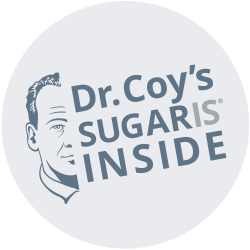Learn more about Dr. Coy and the creation of his sugar solutions.
Dr Johannes Coy is a world-renowned scientist whose research focuses on the health benefits of sugar awareness. Dr Coy has made a number of important genetic discoveries which change our understanding of cancer and nutrition and make him the leading expert on sugars.

Book: Fit with Sugar, by Dr Johannes Coy
Dr Coy has written several books about cancer nutrition. His latest book, Fit with Sugar, is now available. In this book, you’ll discover the evolutionary role of sugar in the human body. Consuming too much conventional sugar isn’t good for our health, but with the right sugars, we can stop cell ageing, keep the brain fit, protect against diseases and switch on fat burning. Find out how you can maintain physical and mental performance using natural low- glycaemic sugars and sugar substitutes. The book includes many delicious recipes for cakes, snacks and desserts, so you can implement a sugar-conscious diet easily and intelligently, without giving up sweet treats.
Buy the book: Cancer-Fighting Diet: Diet and Nutrition Strategies to Help Weaken Cancer Cells and Improve Treatment, by Dr Johannes Coy.
Research & Resources
The beneficial effects of D-allose and D-allulose on the brain under ischemic stroke and obese-insulin resistant conditions: evidence from in vitro to clinical studies
This study reviews current evidence on the neuroprotective effects of rare sugars, particularly D-allose and D-allulose, under both normal and pathological brain conditions such as ischemic stroke and obesity-induced insulin resistance. In vitro findings show that these sugars reduce oxidative stress, inflammation, and neuronal apoptosis by modulating pathways like Gal-3/TLR4 and the unfolded protein response (UPR). In vivo animal models confirm these benefits, with improvements in cognitive and motor function, reduced brain infarct size, and enhanced insulin signaling in the hippocampus. A supporting clinical fMRI study also suggests that allulose uniquely influences brain reward responses and satiety compared to other sweeteners. Overall, the study highlights the therapeutic potential of rare sugars for brain-related disorders and calls for further clinical investigation.
Oral Galactose Provides a Different Approach to Incretin-Based Therapy of Alzheimer’s Disease
Incretin-based drugs, such as GLP-1 and GIP analogues, show promise for treating sporadic Alzheimer’s disease (sAD) due to their neuroprotective and neurotrophic effects. This review highlights oral galactose as a potential sAD therapy, demonstrating its ability to prevent or improve cognitive deficits in a rat model by stimulating GLP-1-mediated effects and normalising cerebral glucose metabolism. Further research is needed to explore galactose’s therapeutic potential, safety, and its interaction with existing GLP-1 therapies.
Trehalose inhibits solute carrier 2A (SLC2A) proteins to induce autophagy and prevent hepatic steatosis
The accumulation of lipids in hepatocytes that occurs in nonalcoholic fatty liver disease (NAFLD) can result in liver failure or liver cancer. Trehalose is a ubiquitous sugar that is present in the food consumed by animals. DeBosch et al. determined that trehalose blocked glucose uptake into cells by inhibiting glucose transporters in the plasma membrane, which induced a “starvation”-like response that activated autophagy even in the presence of adequate nutrients and glucose. Furthermore, providing trehalose to mice that are a model of NAFLD prevented lipid accumulation in the liver. As noted by Mardones et al. in the associated Focus, trehalose, which has been previously under investigation to treat neurodegenerative diseases characterized by toxic protein aggregates, may be a “silver bullet” for treating diseases resulting from inadequate cellular degradative metabolism.
Trehalose alleviates oxidative stress-mediated liver injury and Mallor-Denk body formation via activating autophagy in mice
Trehalose, a disaccharide, has been shown to induce autophagy and reduce cellular stress in various disease models. However, its effects in hepatocytes have not been fully investigated. In a study using mice treated with 3,5-diethoxycarbonyl-1,4-dihydrocollidine (DDC), trehalose was found to induce autophagy, reduce endoplasmic reticulum stress, oxidative stress, Mallory-Denk body formation, and apoptosis in hepatocytes. Electron microscopy revealed the formation of autolysosomes in close proximity to the Mallory-Denk bodies. These findings suggest that trehalose has the potential to be a therapeutic agent for liver diseases associated with oxidative stress by activating autophagy.
Trehalose improves traumatic brain injury-induced cognitive impairment
This study investigated the potential of trehalose, a natural sugar, to treat Alzheimer’s disease (AD) in a mouse model. The study found that trehalose improved the cognitive performance of mice through mechanisms that were independent of the reduction of Aβ protein or activation of autophagy. Trehalose increased the levels of proteins associated with synapses and neurogenesis, suggesting a neuroprotective effect. The study suggests that trehalose may be a potential treatment option for AD and other neurodegenerative disorders.
Trehalose Improves Cognition in the Transgenic Tg2576 Mouse Model of Alzheimer’s Disease
This study investigated the therapeutic effects of trehalose in a mouse model of Alzheimer’s disease (AD). Trehalose treatment improved cognitive performance without significant changes in amyloid-β protein levels or autophagy. There was also no significant alteration in metal levels. However, trehalose treatment led to increased levels of synaptophysin, doublecortin, and progranulin, indicating enhanced synaptic function and neurogenesis. These findings suggest that trehalose may have neuroprotective mechanisms independent of traditional pathways, making it a potential therapeutic option for AD and other neurodegenerative disorders.
Human TKTL1 implies greater neurogenesis in frontal neocortex of modern humans than Neanderthals
This study investigated the role of the TKTL1 gene in neocortex development and its impact on neuroprogenitor numbers. The researchers found that the human-specific amino acid substitution in TKTL1 (hTKTL1) increased the abundance of basal radial glia (bRG), a type of neuroprogenitor associated with increased cortical neuron production. The Neanderthal variant of TKTL1 (aTKTL1) did not have the same effect. Additionally, hTKTL1 promoted the synthesis of specific membrane lipids required for bRG growth. The findings suggest that hTKTL1 contributes to greater neocortical neurogenesis in modern humans, particularly in the frontal lobe, compared to Neanderthals.
Scaling brain neurogenesis across evolution
The neocortex, responsible for cognitive abilities, has expanded and folded in mammals, partly due to basal radial glial cells (bRGs). A study by Pinson et al. reveals that a variant of transketolase-like protein 1 (TKTL1) in modern humans increases the number of bRGs and upper layer projection neurons. This genetic change may contribute to cognitive differences between modern humans and extinct archaic humans.
Trehalose alleviates oxidative stress-mediated liver injury and Mallor-Denk body formation via activating autophagy in mice
This study investigated the effects of trehalose on autophagy, ER stress, oxidative stress-mediated cytotoxicity, and Mallory-Denk body (MDB) formation in hepatocytes. The study used a mice model with 3,5-diethoxycarbonyl-1,4-dihydrocollidine (DDC) treatment and administered trehalose through intraperitoneal injection. The results showed that trehalose induced autophagy, reduced ER stress, oxidative stress, MDB formation, and apoptosis in hepatocytes. Electron microscopy revealed autolysosome formation close to the MDBs. These findings suggest that trehalose has the potential to be a therapeutic agent for oxidative stress-related liver diseases by activating autophagy.
Ketogenic diet – a literature review
The ketogenic diet has gained attention for its potential benefits in various health conditions. It has been found to aid in weight reduction, improve lipid profile, and potentially reduce the need for antidiabetic drugs and insulin therapy in type 2 diabetes. Animal studies suggest positive effects in cancer treatment, although human studies are limited. Additionally, there are reports of the ketogenic diet delaying the onset of dementia symptoms. However, the long-term impact on cardiovascular risk is still unknown, emphasizing the need for careful consideration before adopting the diet.
Glucose levels and risk of dementia
This study examined the relationship between glucose levels and the risk of dementia in individuals with and without diabetes. The study included 2,067 participants without dementia, with 232 having diabetes and 1,835 without. The participants were followed for approximately 6.8 years. The findings showed that higher average glucose levels within the preceding 5 years were associated with an increased risk of dementia in both groups. Among participants without diabetes, higher glucose levels were linked to a 1.18 times higher risk of dementia, and among those with diabetes, higher glucose levels were associated with a 1.40 times higher risk of dementia. These results suggest that elevated glucose levels may be a risk factor for dementia, even in individuals without diabetes.
Higher glucose levels associated with lower memory and reduced hippocampal microstructure
This study examined the impact of glycosylated hemoglobin (HbA1c) and glucose levels on memory in healthy older individuals without diabetes or dementia. Lower HbA1c and glucose levels were associated with better memory performance, and the effects were mediated by changes in the hippocampus. The findings suggest that even within the normal range, higher blood glucose levels can negatively affect memory. Lowering glucose levels may improve cognition in older adults
Risk of dementia and cognitive dysfunction in individuals with diabetes or elevated blood glucose
This study investigated the risk of dementia in individuals with type 1 or type 2 diabetes and those with elevated glycosylated hemoglobin (HbA1c) levels. The findings revealed that both type 1 and type 2 diabetes were associated with a higher risk of dementia. Additionally, high HbA1c levels were linked to lower cognitive performance. However, the significance of screening-detected elevated HbA1c in relation to dementia risk requires further clarification.
Insulin resistance predicts brain amyloid deposition in late middle-aged adults
Insulin resistance (IR) has been linked to an increased risk of Alzheimer’s disease (AD), but its association with amyloid deposition in the brain has not been well-studied. This research involved late middle-aged individuals at risk for AD and used positron emission tomography to measure amyloid levels. The findings revealed that higher insulin resistance was associated with greater amyloid deposition in specific brain regions affected by AD, particularly in participants with normoglycemia. This study provides evidence that insulin resistance may contribute to amyloid accumulation in the brain, shedding light on the relationship between metabolic factors and AD pathology.
Gut microbes modulate neurodegeneration
A recent study investigated the role of gut microbes in tau-mediated neurodegeneration, a major factor in Alzheimer’s disease. The study found that gut bacteria play a causative role in inflammation in the central nervous system and peripheral tissues, leading to neurodegeneration. The inflammation was found to be dependent on the specific isoform of apolipoprotein E and was sex-specific. The study highlights the importance of understanding the interplay between gut microbes, APOE, and tau in the development of Alzheimer’s disease
Centella asiatica Protects d-Galactose/AlCl 3 Mediated Alzheimer’s Disease-Like Rats via PP2A/GSK-3β Signaling Pathway in Their Hippocampus
Alzheimer’s disease (AD) is a neurodegenerative disorder characterized by cognitive decline and brain pathology. Centella asiatica (CA), an herb used in traditional medicine, has shown potential in improving cognitive functions. This study investigated the effects of CA on AD-like pathologies induced in rat models. The results revealed that CA increased the levels of protein phosphatase 2 (PP2A), reduced glycogen synthase kinase-3 beta (GSK-3β) levels, and improved the expression of genes associated with cell survival. Additionally, CA prevented structural abnormalities in the hippocampus. This study suggests that CA may have a protective effect against AD-like pathologies by regulating tau proteins, promoting cell survival, and maintaining brain structure.
Metabolism of galactose in the brain and liver of rats and its conversion into glutamate and other amino acids
This animal study measured galactose uptake in various organs. It demonstrated that the liver, brain and muscles can use galactose. They showed that galactose concentrations in the brain remain higher for longer, demonstrating its ability to provided a more sustaining energy. They also found that galactose enhanced the breakdown of toxic ammonia and proposed “galactose as a new means of removal of this neurotoxic compound from the brain in patients suffering from hepatic encephalopathy or Alzheimer’s disease”.
Nicotinamide ribose ameliorates cognitive impairment of aged and Alzheimer’s disease model mice
In this study, the researchers investigated the effects of nicotinamide ribose (NR) supplementation in mice models of Alzheimer’s disease (AD) and aging. The mice were given NR-supplemented food for three months, and their cognitive function, behavior, pathological processes, and biomarkers were assessed. The findings revealed that NR supplementation improved short-term spatial memory in aged mice and contextual fear memory in AD mice. It also inhibited astrocyte activation and reduced the accumulation of amyloid-beta (Aβ) plaques in the brains of AD mice. Additionally, NR supplementation prevented weight gain in both aged and AD mice. These results suggest that NR has selective benefits for AD and aged mice, highlighting its potential as a preventive measure against dementia.
Trehalose improves traumatic brain injury-induced cognitive impairment
In this study, researchers investigated the therapeutic potential of trehalose in a mouse model of traumatic brain injury (TBI). Trehalose, known for its neuroprotective properties, was found to improve behavioral performance in TBI mice without affecting lesion volume or biometals. However, trehalose treatment resulted in an upregulation of synaptic proteins and neurotrophic factors in the contralateral cortex. These findings suggest that trehalose could be an effective treatment option for TBI and other central nervous system disorders
Trehalose Improves Cognition in the Transgenic Tg2576 Mouse Model of Alzheimer’s Disease
This study investigated the therapeutic effects of trehalose in a mouse model of Alzheimer’s disease (AD). Trehalose treatment improved cognitive performance without significant changes in amyloid-β protein levels or autophagy. There was also no significant alteration in metal levels. However, trehalose treatment led to increased levels of synaptophysin, doublecortin, and progranulin, indicating enhanced synaptic function and neurogenesis. These findings suggest that trehalose may have neuroprotective mechanisms independent of traditional pathways, making it a potential therapeutic option for AD and other neurodegenerative disorders.
Human TKTL1 implies greater neurogenesis in frontal neocortex of modern humans than Neanderthals
This scientific article explores the differences in neurogenesis (the formation of new neurons) between modern humans and Neanderthals. Although Neanderthals had brains similar in size to modern humans, researchers discovered a genetic difference in a specific protein called transketolase-like 1 (TKTL1). The modern human variant of this protein, hTKTL1, was found to increase the abundance of basal radial glia (bRG) during neocortex development. These bRG cells play a crucial role in generating neurons. However, the Neanderthal variant of the protein did not have the same effect on bRG. The study suggests that modern humans have a different process of neurogenesis compared to Neanderthals, which may have contributed to unique characteristics of the human brain.
Trehalose alleviates oxidative stress-mediated liver injury and Mallor-Denk body formation via activating autophagy in mice
Trehalose, a disaccharide, has been shown to induce autophagy and reduce cytotoxicity in neurodegenerative diseases. However, its effects on hepatocytes are not fully understood. In a study using a mice model of liver disease, trehalose was found to induce autophagy and decrease ER stress, oxidative stress, Mallory-Denk body (MDB) formation, and apoptosis in hepatocytes. The results suggest that trehalose could be a potential therapeutic agent for oxidative stress-related liver diseases by activating autophagy.
KATP channels are necessary for glucose-dependent increases in amyloid-β and Alzheimer’s disease–related pathology
High blood glucose levels can contribute to Alzheimer’s disease (AD), but the underlying mechanisms are unclear. This study focused on ATP-sensitive potassium (KATP) channels and their role in AD. They found that these channels were present in the human brain and changed with AD progression. Using a mouse model, they discovered that blocking KATP channels reduced the effects of high glucose on Aβ levels, plaque formation, and amyloid precursor protein processing. These findings suggest that targeting KATP channels could be a potential treatment strategy for AD in individuals with diabetes or prediabetes.
Get in touch with Intelligent Sugar
Got a question about Dr Coy’s sugars? Contact info@intelligentsugar.info
If you have a question about a specific health condition, please speak to your doctor.

